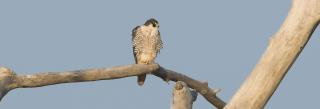
Peregrine Falcon
| Scientific Name | Falco peregrinus |
|---|---|
| General Description | L 16”, WS 41”, 1.6 lb. Dark, slate gray back and sports an obvious black “mustache.” |
| Status | Most often seen mid-April through May and September through mid-November. Peak breeding season early May to late July. |
| Abundance | Rare. |
| Primary Habitat | Expanses of native prairie, badland complexes, and open waterways. |
| Federal Status | Migratory Bird. |
| Reason for Designation | Peregrine Falcons are nearly recovered from steep population declines. Removed from the endangered species list on August 25, 1999. It is included on the National USFWS Birds of Conservation Concern list, and also in Region 6, BCR 11 and 17. |
Locations and Conditions of Key Habitat
Preferred Habitat
Peregrine Falcons may be observed using open expanses of native prairie, badland complexes, rocky cliffs overlooking rivers, lakes, or other water in North Dakota. They do not build their own nest, but instead nests in a scraped out hollow on ledges, in crevices of steep sides of buttes, on tall buildings, or other high structures. Prey upon pigeons, grebes, ducks, and a variety of other small to medium sized birds.
Key Areas and Conditions for Peregrin Falcon in North Dakota
No specific sites have been identified. The most recently confirmed naturally occurring nest was in 1954 on Bullion Butte in Billings County.
Problems Which May Affect this Species
Habitat
Loss of nesting sites such as cliffs, ledges, or trees, are often irreplaceable and may be the primary habitat factor limiting peregrines. Peregrines may become comfortable with human activities, hence their tolerance for nesting within city limits.
Other Natural or Manmade Factors
Illegal shooting and the effects of DDT on reproductive success were also to blame for decline of the species; however, since the ban of DDT and stricter enforcement, peregrines have been increasing. The falcons may become infected with trichomoniasis from eating infected doves and pigeons.
Research and Survey Efforts
Current Research or Surveys
- Nothing specific to the species in North Dakota.
Previous Research or Surveys
- Little effort has been directed to specific research or surveys for Peregrine Falcons in North Dakota, other than historical notes on species occurrence or breeding.
- Numerous published reports and gray literature throughout the species range, one of the most studied avian species.
Additional Research or Surveys Needed
Population and Trend Estimates
- PIF Global Population Estimate: 140,000
- North Dakota Number of Occupied Nests: 2 on artificial structures
Management Recommendations
- Maintain a buffer zone of no disturbance around aeries if found (i.e. from roads, mining operations).
- Utility development should follow the guidance of “Suggested Practices for Avian Protection on Power Lines: The State of the Art in 2006” and “Reducing Avian Collisions with Power Lines” including marking power lines and creating an Avian Protection Plan.
Monitoring Plans
According to the Partners in Flight Landbird Conservation Plan, long-term population trend monitoring such as the Breeding Bird Survey produces imprecise trends for this species and is inadequate in the northern range. Most Peregrine Falcons are observed during spring and fall migration. A monitoring plan specific to Peregrine Falcons is not needed, the NDGF will monitor if any potential breeding observations are reported.
2005-2015 Progress
The Peregrine Falcon remains a Level III Species of Conservation Priority.

Note: A listing of works consulted when compiling the information on this page may be found in the 2015 State Wildlife Action Plan.
